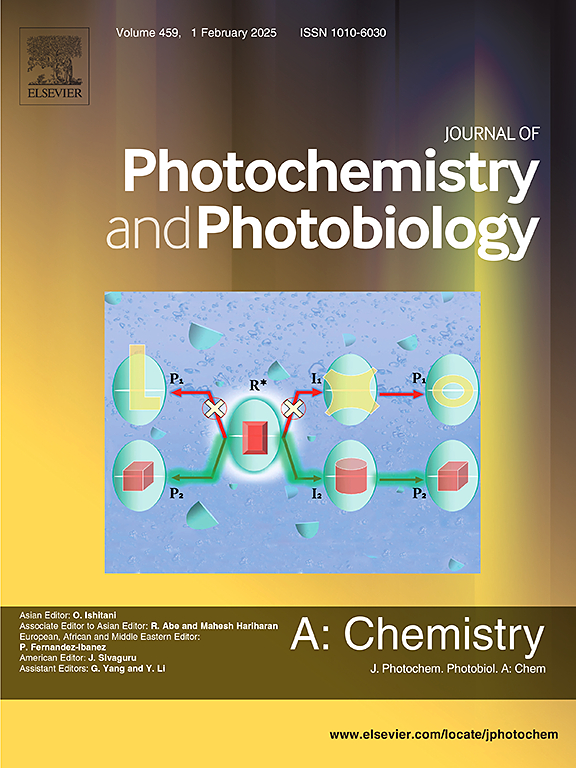Decolorization of Acid Red 337 dye with hydroxyl and sulfate radical based advanced oxidation processes using different iron Catalyst: An experimental and statistical Investigation
IF 4.1
3区 化学
Q2 CHEMISTRY, PHYSICAL
Journal of Photochemistry and Photobiology A-chemistry
Pub Date : 2024-10-21
DOI:10.1016/j.jphotochem.2024.116105
引用次数: 0
Abstract
The removal efficiencies of Acid Red 337 dye were investigated by combining advanced oxidation processes based on ![]() OH and SO4
OH and SO4![]() − radicals. The photocatalytic oxidation processes were carried out at the natural pH (5.4) and acidic pH (3.0) values of the dye solution. In the experiments, iron (II) sulfate (Fe2+) and potassium ferrioxalate (FeOx) were used as catalysts, hydrogen peroxide (H2O2) and peroxymonosulfate (PMS) were used as oxidants to compare dye removal efficiency and to determine the optimum doses. This comparison provided the opportunity to identify suitable catalysts and oxidants for dye removal. Furthermore, time-based comparisons were conducted from 2 to 10 min using the optimum catalyst doses. It was obtained that PMS was more effective as an oxidant in the presence of both iron catalysts for colour removal. The colour removal efficiency of 98.2 % was achieved in the PMS/Fe2+/UV process with doses of 1 mM PMS and 0.1 mM Fe2+ at pH 5.4 and an irradiation time of 10 min. In experiments using light-sensitive ferrioxalate (FeOx), colour removal was achieved in the PMS/FeOx/UV process with an efficiency of 97.8 %. Additionally, an artificial neural networks (ANNs) model effectively optimized the oxidation parameters, with predicted values closely matching the experimental data. The ANNs model yielded excellent statistical performance, with a root mean square error (RMSE) of 0.0317, 0.0223 and coefficient of determination (R2) of 0.9690 and 0.9854 for UV/Fe2+/H2O2-UV/FeOx/H2O2 and UV/Fe2+/PMS-UV/FeOx/PMS oxidation systems respectively.
− radicals. The photocatalytic oxidation processes were carried out at the natural pH (5.4) and acidic pH (3.0) values of the dye solution. In the experiments, iron (II) sulfate (Fe2+) and potassium ferrioxalate (FeOx) were used as catalysts, hydrogen peroxide (H2O2) and peroxymonosulfate (PMS) were used as oxidants to compare dye removal efficiency and to determine the optimum doses. This comparison provided the opportunity to identify suitable catalysts and oxidants for dye removal. Furthermore, time-based comparisons were conducted from 2 to 10 min using the optimum catalyst doses. It was obtained that PMS was more effective as an oxidant in the presence of both iron catalysts for colour removal. The colour removal efficiency of 98.2 % was achieved in the PMS/Fe2+/UV process with doses of 1 mM PMS and 0.1 mM Fe2+ at pH 5.4 and an irradiation time of 10 min. In experiments using light-sensitive ferrioxalate (FeOx), colour removal was achieved in the PMS/FeOx/UV process with an efficiency of 97.8 %. Additionally, an artificial neural networks (ANNs) model effectively optimized the oxidation parameters, with predicted values closely matching the experimental data. The ANNs model yielded excellent statistical performance, with a root mean square error (RMSE) of 0.0317, 0.0223 and coefficient of determination (R2) of 0.9690 and 0.9854 for UV/Fe2+/H2O2-UV/FeOx/H2O2 and UV/Fe2+/PMS-UV/FeOx/PMS oxidation systems respectively.

使用不同铁催化剂的基于羟基和硫酸根自由基的高级氧化工艺对酸性红 337 染料进行脱色:实验和统计调查
通过结合基于 OH 和 SO4- 自由基的高级氧化过程,研究了酸性红 337 染料的去除率。光催化氧化过程是在染料溶液的自然 pH 值(5.4)和酸性 pH 值(3.0)下进行的。在实验中,硫酸铁 (II) (Fe2+) 和草酸铁钾 (FeOx) 被用作催化剂,过氧化氢 (H2O2) 和过氧化单硫酸盐 (PMS) 被用作氧化剂,以比较染料去除效率并确定最佳剂量。这种比较为确定合适的染料去除催化剂和氧化剂提供了机会。此外,还使用最佳催化剂剂量进行了 2 至 10 分钟的时间比较。结果表明,在两种铁催化剂的作用下,PMS 作为氧化剂的脱色效果更好。在 pH 值为 5.4、辐照时间为 10 分钟、剂量为 1 mM PMS 和 0.1 mM Fe2+ 的 PMS/Fe2+/UV 工艺中,色素去除率达到 98.2%。在使用光敏氧化铁(FeOx)的实验中,PMS/FeOx/紫外线工艺的脱色效率高达 97.8%。此外,人工神经网络(ANNs)模型有效地优化了氧化参数,预测值与实验数据非常吻合。人工神经网络模型具有出色的统计性能,UV/Fe2+/H2O2-UV/FeOx/H2O2 和 UV/Fe2+/PMS-UV/FeOx/PMS 氧化系统的均方根误差 (RMSE) 分别为 0.0317 和 0.0223,判定系数 (R2) 分别为 0.9690 和 0.9854。
本文章由计算机程序翻译,如有差异,请以英文原文为准。
求助全文
约1分钟内获得全文
求助全文
来源期刊
CiteScore
7.90
自引率
7.00%
发文量
580
审稿时长
48 days
期刊介绍:
JPPA publishes the results of fundamental studies on all aspects of chemical phenomena induced by interactions between light and molecules/matter of all kinds.
All systems capable of being described at the molecular or integrated multimolecular level are appropriate for the journal. This includes all molecular chemical species as well as biomolecular, supramolecular, polymer and other macromolecular systems, as well as solid state photochemistry. In addition, the journal publishes studies of semiconductor and other photoactive organic and inorganic materials, photocatalysis (organic, inorganic, supramolecular and superconductor).
The scope includes condensed and gas phase photochemistry, as well as synchrotron radiation chemistry. A broad range of processes and techniques in photochemistry are covered such as light induced energy, electron and proton transfer; nonlinear photochemical behavior; mechanistic investigation of photochemical reactions and identification of the products of photochemical reactions; quantum yield determinations and measurements of rate constants for primary and secondary photochemical processes; steady-state and time-resolved emission, ultrafast spectroscopic methods, single molecule spectroscopy, time resolved X-ray diffraction, luminescence microscopy, and scattering spectroscopy applied to photochemistry. Papers in emerging and applied areas such as luminescent sensors, electroluminescence, solar energy conversion, atmospheric photochemistry, environmental remediation, and related photocatalytic chemistry are also welcome.

 求助内容:
求助内容: 应助结果提醒方式:
应助结果提醒方式:


